Why Materiality Matters
The concept of materiality sits at the heart of best practice identification, management and reporting of sustainability risks and opportunities. It guides the prioritisation of those risks and opportunities that can significantly impact our business and/or are most important to our stakeholders.
As a demonstration of our sustainability leadership, New Forests regularly assesses materiality, guided by sustainability-related reporting frameworks including the Integrated Reporting (IR) Framework, the Global Reporting Initiative (GRI), the Taskforce on Climate Related Disclosures (TCFD), the Taskforce on Nature Related Disclosures (TNFD) and the nascent International Sustainability Standards Board (ISSB).
Done well, a materiality assessment should do more than inform our sustainability management and reporting. A refreshed understanding of the environmental, social, and governance themes that are most important to stakeholders is a valuable input to strategic planning, helping to inform business strategy and resource allocation and guide performance measurement.
This year we evolved our Materiality Assessment to incorporate a double materiality approach to understand the environmental, social or governance themes of significant to our stakeholders (impact materiality), the themes which most affect New Forests’ business going forward (financial materiality) and those themes which are material from both an impact and financial lens.
We also expanded the number and types of stakeholders engaged, for example, including Environmental NGOs as a proxy for the environment, given our reliance on nature as manager of nature-based real assets and natural capital strategies.
For stakeholders as a whole, the most material themes are Health and safety; Managed forest health; Labour rights, Land conversion/deforestation; and Transparency. These themes mostly relate to foundational aspects for conducting business responsibly and profitably in the forestry and land use sector.
Managed forest health and Land conversion/deforestation also demonstrate high impact and financial materiality. Managed forest health, defined as ‘the overall condition, vitality, and resilience of a managed forest or plantation’ is core to profitable forestry.
The prioritisation of Land conversion/deforestation, defined as ‘conversion of intact natural ecosystems to alternative land use’, likely reflects the heightened attention around deforestation globally and its role in climate change and nature loss, reflected in recent initiatives such as the European Union Deforestation Regulation and Kunming-Montreal Global Biodiversity Framework.
By region or stakeholder type, Human rights and Labour rights are top themes for stakeholders in Africa and Asia, with Managed forest health the top theme in North America and Australia.
Top themes for both impact and financial materiality, Health and safety is the most significant theme. This is an important result, reinforcing that the wellbeing of workers is foundational to the business, ahead of all other activity.
What is material to stakeholders is subject to change, and shifts can be rapid depending on the social, economic and political environment. New Forests is committed to reassessing materiality on a regular basis to understand changing priorities and emerging material topics which can affect our ability to create value.
Download the Materiality Assessment.



